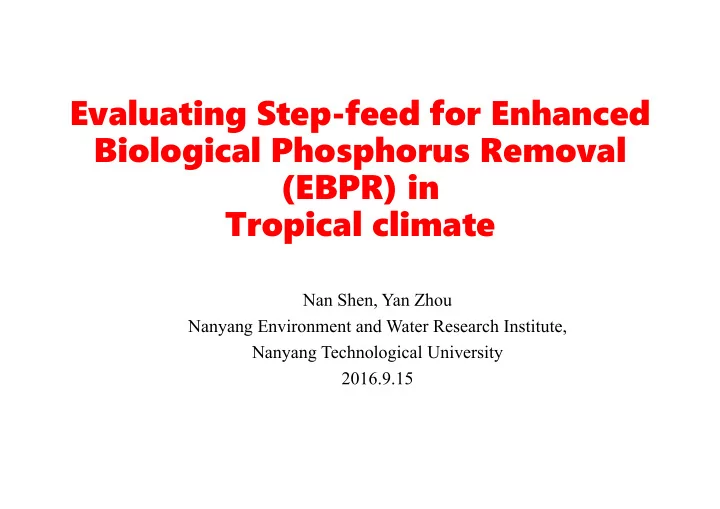

Evaluating Step-feed for Enhanced Biological Phosphorus Removal (EBPR) in Tropical climate Nan Shen, Yan Zhou Nanyang Environment and Water Research Institute, Nanyang Technological University 2016.9.15
Introduction GAOs are the major competitor of PAOs that causes EBPR failure, especially under tropical climate Many studies indicate that the employment of EBPR in tropical climate is challenging It is known that deterioration of EBPR occurs when temperature is higher (25~30 o C) However, a few successful EBPR processes operated at high temperature shed some light on the feasibilities of high temperature EBPR Feeding strategy and carbon source effect on EBPR in tropical climate
Reactor setup Temperature was maintained at 30-32 o C Acetate Step-feeding strategy Propionate HRT of 12 h SRT of 7.5 days pH of 7.2-8.0 Time (min) Stage 1 Stage 2 Stage 3 Days 0-86 87-263 264-345 DO of 2-3 mg/L A 40 35 40 O 60 65 60 400 COD, 20 P; COD/P of 20 300 COD, 15 P.
Results SBRs performance
Results Cyclic study during stage 2 and 3 PHB was the major PHA component in C2 SBR (80.23-97.01%% of total PHA) PHV (57.20-68.67%) and PH2MV (26.95- 40.81%) in C3 SBR Carbon uptake and P release rates were higher at high temperature PHA composition: similar with the results reported under lower temperature The fractions of PHA and glycogen in biomass were lower at high temperature
Results Stoichiometric ratios of P and C transformation C2-SBR C3-SBR Anaerobic phase Aerobic phase Anaerobic phase Aerobic phase P PHB/C PHV/C Gly/C C- P uptake P/PHA Gly/PHA P PHB/C PHV/C PH2MV/ Gly/C C- P uptake P/PHA Gly/PHA The ratio of P/C was higher at high temperature, maintenance energy release/C C- C- mol/C- mmol/g mol/C- C- release/C C- C- C C- mol/C- mmol/g mol/C- C- P-mol/C- mol/C- mol/C- mol VSS h mol mol/C- P-mol/C- mol/C- mol/C- mol/C- mol VSS h mol mol/C- mol mol mol mol mol mol mol mol mol Most PHA/C ratios were lower than the model under lower temperature Sub- 0.823- 0.849- 0.138- 0.277- 0.712- 0.686- 0.139- 0.587- 0.024- 0.558- 0.263- 0.281- 0.503- 0.603- 0.127- Most Gly/C ratios were lower than the model under lower temperature, PAM dominated cycle 1 0.966 1.100 0.271 0.383 0.736 1.056 0.258 0.731 0.080 0.721 0.532 0.449 0.537 0.702 0.192 Sub- 0.654- 0.779- 0.024- 0.118- 0.571- 0.778- 0.223- 0.370- 0.009- 0.458- 0.275- 0.033- 0.461- 0.782- 0.179- P/PHA ratios under high temperature were higher than lower temperature cycle 2 0.730 0.875 0.150 0.531 0.698 0.914 0.256 0.591 0.031 0.709 0.404 0.212 0.501 0.993 0.242 Sub- 0.692- 0.833- 0.040- 0.234- 0.606- 0.804- 0.264- 0.404- 0.020- 0.457- 0.268- 0.163- 0.457- 0.905- 0.281- cycle 3 0.762 0.989 0.151 0.423 0.701 0.957 0.354 0.634 0.063 0.689 0.352 0.248 0.504 0.906 0.401 * 0.723- 0.821- 0.069- 0.244- 0.639- 0.751- 0.214- 0.454- 0.025- 0.491- 0.268- 0.162- 0.474- 0.737- 0.189- Normaliz 0.819 0.964 0.189 0.407 0.709 0.979 0.277 0.652 0.050 0.706 0.429 0.303 0.514 0.844 0.262 ed value Model 0.50 1.33 0.50 0.42 1.22 0.33
Results FISH for PAO and GAO C2 SBR C3 SBR GAO PAO GAO PAO EUB EUB PAO dominated in both reactors during steady state. The morphology of PAO in the 2 SBRs was different.
Results icrobial community dynamics in C2 SBR Possible PAO in class Betaproteobacteria Betaproteobacteria Enrichment period Gammaproteobacteria Possible GAO in class Gamaproteobacteria Decreased to a lower level Ignavibacteria Bacteroidetes incertae sedis Sphingobacteriia
Results icrobial community dynamics in C3 SBR Bacteroidetes incertae sedis Sphingobacteriia Flavobacteriia Possible PAO in class Betaproteobacteria Betaproteobacteria No obvious increase trend
Results FISH and qPCR C2-SBR C3-SBR Time Time day) (day) PAO% GAO% PAO% GAO% 71 30.16 25.75 71 20.19 10.32 138 74.65 9.54 157 53.29 2.28 178 52.51 20.55 190 31.57 8.12 306 63.92 20.76 319 11.04 35.91 microbial community structure was more stable in C2-SBR than C3-SBR
Conclusions ed operation could support a good EBPR performance with C2 and C3 at mperature and C2 SBR was more stable of the C and P transformation ratios of both reactors were higher at high rature than lower temperature fractions of PHA and glycogen in biomass were lower with step-feeding pared with pulse feeding, high turnover rate e microbial community structure was more stable in C2-SBR than that in C3- R
Thank you for your attention!
Recommend
More recommend